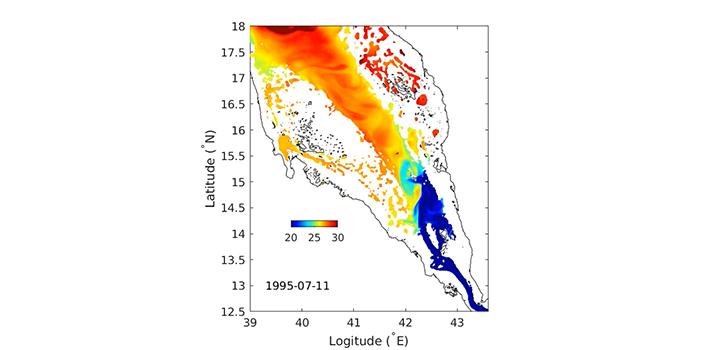© 2019 KAUST
Computer simulations show that water exchange between the Red Sea in the north and the Gulf of Aden in the south varies from season to season and year to year. The findings help explain the circulation and productivity of the Red Sea Basin, instructing longterm management.
KAUST ocean modeling expert, Ibrahim Hoteit, and colleagues used an advanced computer simulation approach to obtain a detailed, high-resolution, multiyear view of water exchanges at the Bab al-Mandab Strait, a narrow waterway that links the Red Sea to the Indian Ocean.

The Strait of Bab-el-Mandeb, as simulated by the KAUST model, shows the intrusion of the cold Gulf of Aden water into and out of the Red Sea in the summer at a depth of 80 meters.
Reproduced with permission from reference 1 © 2019 American Geophysical Union
In the strait during winter, an upper layer of freshwate flows from the Gulf of Aden into the Red Sea, while a lower layer of highly saline water flows in the opposite direction. During summer, a shallow, warm surface layer and a deep, weakly flowing salty layer of outflow from the Red Sea sandwich a fresh, cold layer of inflowing water from the Gulf of Aden. How this winter/summer pattern varies seasonally and interannually has been poorly understood.
The simulations revealed that the switch between the winter and summer patterns occurs approximately one to two weeks after a monsoon-driven wind reversal over the Gulf of Aden. There was considerable variation from year to year in the timing of the switch happened, and also for the longevity of each seasonal pattern. The summer water exchange appeared to be increasing in length by 1.45 days per year, while the winter exchange is decreasing by about 1.22 days/year. Also, the total volume of water, salt mass and stored heat exchanged between the Red Sea and the Gulf of Aden varies significantly from year to year.
“These interannual variations and trends could have very important implications on the thermohaline—the temperature and salt—structure of the Red Sea and on the functioning of its ecosystem,” says the study’s first author, Jieshuo Xie.
Read the full article
